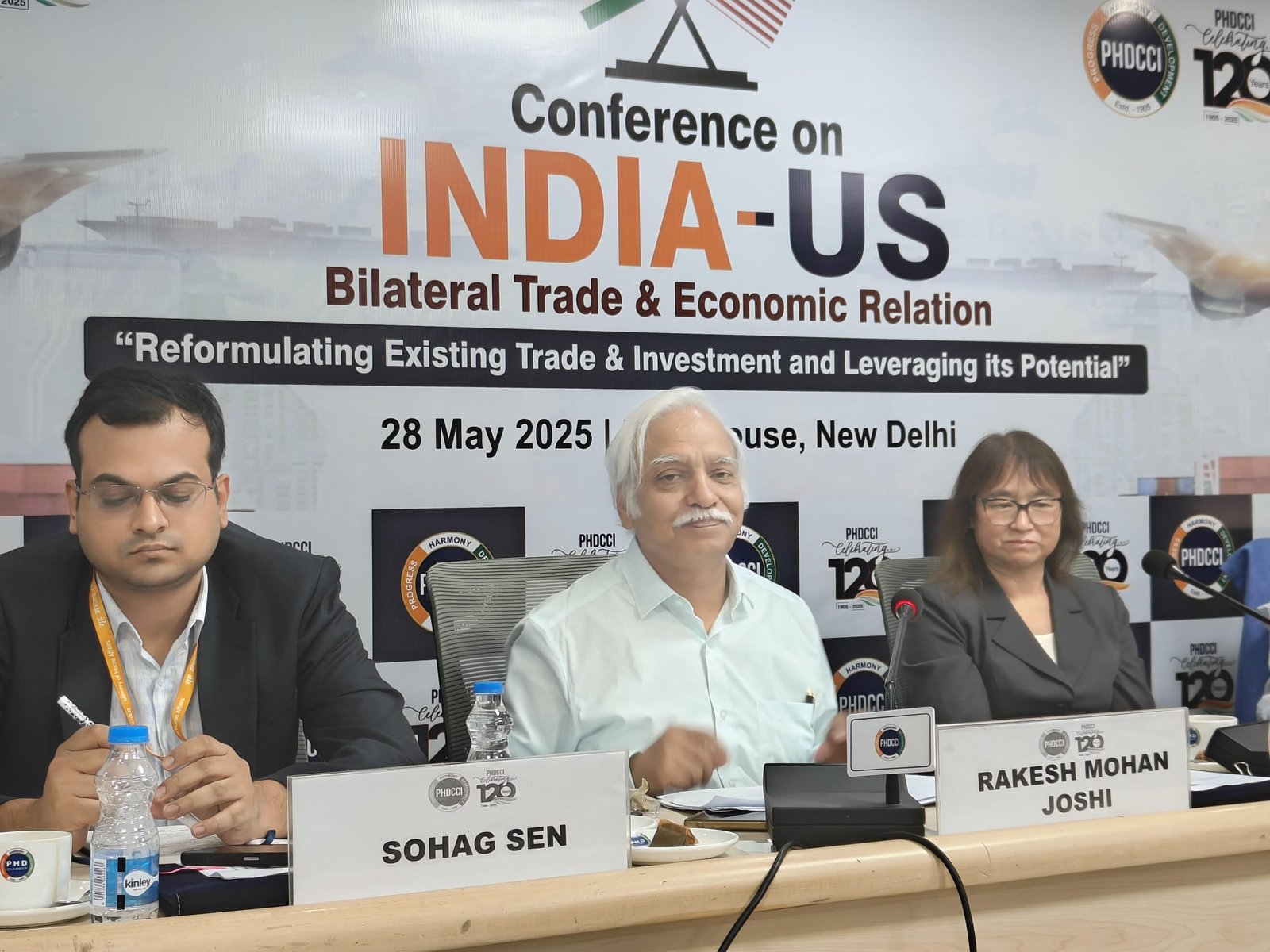
At the recent Conference on “India–U.S. Bilateral Trade & Economic Relations”, organised by the PHD Chamber on 28th May 2025, Prof. R.M. Joshi, Vice Chancellor of the Indian Institute of Foreign Trade (IIFT), urged policymakers, academia, and business leaders to reframe the bilateral discourse through the lens of complementarity rather than competition.
Bringing an academic perspective to a dialogue otherwise dominated by industry and government voices, Prof. Joshi set the tone by reflecting on the broader global trade architecture. “U.S. tariffs today are nearly at the same levels they were a hundred years ago,” he noted. “Such a scenario raises fundamental questions about the evolving nature of globalisation and the shifting contours of trade relations.”
Despite such uncertainties, he stressed that India and the United States are well-positioned to forge a resilient and future-ready economic partnership. “If approached with a spirit of complementarity rather than competition, India and the U.S. can indeed be natural partners in this journey,” he said, referencing the phrase “Make America Great Again.”
India’s Economic Leap
Citing recent data, Prof. Joshi highlighted India’s remarkable economic trajectory. “India’s GDP has reached $4.187 trillion, surpassing Japan to become the world’s third-largest economy,” he shared. “Very soon, we are poised to overtake Germany as well.”
This economic rise, he emphasised, is anchored in India’s entrepreneurial strength and increasing global integration. “Our trade in goods and services now contributes 23% to our GDP—up from just 4% in 1970,” he added, underscoring the transformation.
The Services Edge
India’s expanding role in the global services economy also received focus. “In terms of GDP contribution, India’s services exports are the second-highest in the world after the United Kingdom,” Prof. Joshi noted. “We are rapidly climbing the global value chain—especially in areas such as IT, knowledge-based services, consulting, finance, and digital transformation.”
He emphasised the linguistic advantage that helps India thrive in this space: “The U.S. recently declared English as its official language. India, with over 280 million English speakers, is uniquely positioned to benefit from this.”
Leveraging Human Capital
The India–U.S. partnership also thrives on educational and professional exchange. “In 2024, over 337,000 Indian students pursued higher education in the United States—forming the largest international student cohort,” said Prof. Joshi. “From Google and Microsoft to Harvard, Indian-origin talent is at the helm. The world is recognising that if you want to find exceptional CEOs or deans, you often need to look to India.”
Pharmaceuticals and Public Health
Turning to healthcare and pharmaceuticals, Prof. Joshi illustrated India’s leadership in affordable medicines. “India supplies nearly 38–40% of all generics consumed in the U.S.,” he said. He cited the dramatic drop in HIV treatment costs—from $6,000 to $100–150—thanks to Indian pharmaceutical firms like Cipla. “This is a powerful example of what India can do for global health,” he stressed.
The recent U.S. proposal to benchmark domestic drug prices against global lows could further open space for Indian generics. “While this has sent shockwaves through the American pharmaceutical industry, it also opens up the space for affordable, generic medicines—a space where India already leads.”
Agriculture, Dairy, and Trade Asymmetries
Prof. Joshi also touched on agriculture and trade asymmetries. While the U.S. dominates global agricultural exports, India’s dairy sector is a model of resilience and scale. “In India, nearly 80 to 100 million people rely directly or indirectly on dairy for livelihood,” he said. “From being a net importer, India today is the world’s largest milk producer—more than 130 million metric tonnes annually.”
Yet challenges persist. “We face unfair trade practices,” he pointed out, referring to the cotton sector and India’s difficulties in competing with heavily mechanised U.S. farms. He also highlighted a $1 billion trade deficit in fresh fruits and the irony of premium U.S. produce flooding Indian markets while domestic exports face barriers. “Even when we produce high-quality varieties like Himachal or Kashmir apples, we’re told to ‘buy American,’” he remarked.
The Call for Reciprocity
Prof. Joshi questioned the global double standards on protectionism. “India’s Swadeshi movement is often criticised as regressive, while similar policies abroad are applauded as progressive,” he observed, comparing Brexit and “Atmanirbhar Bharat.”
“Despite India’s trade deficit of $260 billion, we’re still expanding exports,” he said. “Yet Indian products often face tariffs of 10–25%, while others enjoy near-zero rates. Reciprocity in trade is essential, but not always honoured.”
Redefining Global Trade Norms
Concluding with a call for balance and fairness, Prof. Joshi warned against the rise of “theatre tariffs”—a trend where high proposed duties create uncertainty and serve as negotiation tactics. “This isn’t just trade policy—it’s economic theatre,” he said. “Protectionism is real, and it’s not just about America. It’s about every country rethinking its place in a rapidly shifting global order.”
Leave a Reply